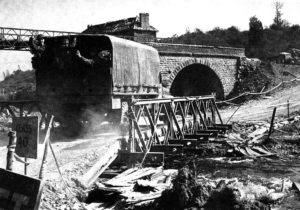Thury-Harcourt (Calvados)
The cities of Normandy during the 1944 battles
During the second half of August 1944, British troops crossed the Orne River at a Bailey bridge in Brieux, north of Thury-Harcourt, the scene of fierce fighting between the 12th SS Panzer Division and the 176th Infantry Brigade.
Photo: IWM
- Liberation: 14 August 1944
- Deployed units:
![]() 59th (Staffordshire) Infantry Division
59th (Staffordshire) Infantry Division
![]() 56th Independent Brigade
56th Independent Brigade
![]() 2nd Battalion Gloucestershire Regiment
2nd Battalion Gloucestershire Regiment
![]() 12. SS-Panzer-Division « Hitlerjugend »
12. SS-Panzer-Division « Hitlerjugend »
- History:
The town of Thury-Harcourt, located at the intersection of several roads and near the Orne River, was scheduled to come under Allied control just eight days after the landings (on June 14th) according to Overlord Planning Directive Number Seven, published in February 1944. In reality, this liberation was delayed by exactly two months. During this interim period, the village was regularly bombed by the Allies (particularly on June 30th, which caused numerous casualties among the population) in an attempt to slow the flow of German reinforcements to the front, which could, in particular, cross the Orne in this sector. As a result, the damage was extensive, and nearly 80% of Thury-Harcourt was destroyed.
At the end of Operation Bluecoat launched on July 30 by the British 2nd Army, the German lines were broken: on August 4, Generalfeldmarschall von Kluge (commanding Army Group B) called for final reinforcements and decided to withdraw his troops behind the Orne in the Thury-Harcourt sector. This withdrawal allowed the 59th (Staffordshire) Infantry Division to quickly reach the west bank of the Orne. The 176th Infantry Brigade of the 59th Infantry Division crossed the Orne during the night of August 6 to 7 and managed to establish a bridgehead west of Moutiers-en-Cinglais (place called Brieux) before turning south towards Thury-Harcourt. The British 176th Infantry Brigade repelled several German counterattacks, losing nearly 200 prisoners while attempting to regain control of the bridge over the Orne. For their part, the infantrymen of the 5th Battalion, The South Staffordshire Regiment, reached the heights of La Métairie, northwest of Thury-Harcourt, on August 10, from where artillery observers could direct their fire.
The Germans of the 12th SS Panzer Division prepared to defend the village and set up their reserve in Milleharts Wood (commune of Esson), sheltered from air raids. On the evening of August 10, they repelled an initial offensive launched by the 2nd Battalion, Gloucestershire Regiment (temporarily attached to the 176th Infantry Brigade) northeast of Thury-Harcourt, between Courmeron and Le Moncel. But the noose tightened around the Germans, and the British gained ground by the hour. The soldiers of the 12th SS Panzer Division realized that their situation was untenable and that they were now in danger of being surrounded. They made their first attempt to escape on August 11 through Milleharts Wood, but some of them were repelled by men of the 2nd Battalion Gloucestershire Regiment.
On August 12, after some of the Germans had managed to escape from the trap closing in on them, the 56th Independent Brigade launched a new assault starting at 2:30 p.m. from the Hom and La Vallée sector, with the support of Allied artillery. The German defense relied on Harcourt Castle, whose outskirts and approaches to the village had been meticulously booby-trapped. The British infantry assault broke against this solid defensive line and ceased at nightfall. The Germans abandoned the castle that night after carefully setting it on fire and adding explosive booby traps.
At first light on August 13, soldiers of the 2nd Battalion Gloucestershire Regiment resumed reconnaissance through the ruined village and were informed by the locals that the Germans had left the castle, which was still engulfed in flames. The British advance was severely hampered by mines and improvised explosive devices. Meanwhile, the 177th Infantry Brigade approached Thury-Harcourt from the south. A full reconnaissance of the town was not completed until late morning. In total, 261 British soldiers were killed in the fighting in the Thury-Harcourt area: 240 from the 59th Infantry Division, 21 from the 56th Independent Brigade and 6 from the 2nd Battalion Gloucestershire Regiment.
Thury-Harcourt map:
![]() Back to the Normandy cities in 1944
Back to the Normandy cities in 1944

